Keywords:AI Agent, Large Language Model, Automated Document Processing, CondoScan Apartment Evaluation Tool, LlamaIndex Agent Workflow, LlamaParse Document Processing, Real Estate AI Automation, Financial Document AI Analysis, AI-powered Home Buying Process Optimization, Automation of Document-intensive Tasks, AI Agent Workflow
🔥 Focus
CondoScan Simplifies Condo Buying Process Using LlamaIndex and LlamaParse: CondoScan has built an automated condo assessment tool using LlamaIndex’s agent workflows and LlamaParse’s document processing technology. The tool aims to reduce weeks of document review time to minutes, evaluating a condo’s financial health and lifestyle fit, significantly improving the efficiency and accuracy of the home buying process. This demonstrates the huge potential of AI agents in automating complex, document-intensive tasks, especially in traditional industries like real estate (Source: jerryjliu0)

Experience Sharing: Large-Scale Enterprise Deployment of ChatGPT: A company rolled out the enterprise version of ChatGPT to 6,000 employees and found that over half had never used it before. The deployment integrated tools like Slack, Confluence, and Google Drive, showcasing AI’s potential in areas like HR and financial data analysis. The deployment process faced information security challenges, particularly the need to manage internal document permissions to prevent sensitive information leaks. Despite the challenges, the tool significantly improved the efficiency of accessing the internal knowledge base, indicating that generative AI, as an auxiliary tool within enterprises, can effectively boost employee efficiency (Source: Reddit r/ArtificialInteligence)
Discussion Sparked on AI’s Impact on Search Engines and SEO: Community discussion suggests that AI is changing information retrieval methods, potentially diminishing the importance of traditional search engines and SEO. Reasons include: users preferring to ask AI directly rather than searching; companies like Google potentially focusing more on promoting their own AI; content creators moving to closed platforms (like social media, Discord), reducing indexable open content; AI-generated summaries potentially reducing traffic to source websites. This raises concerns about the future web information ecosystem, content quality, and incentive mechanisms for content creators (Source: Reddit r/ArtificialInteligence)
DeepSeek R2 Rumored for Imminent Release: Community rumors suggest DeepSeek is about to release its R2 model. It is rumored that the model might be trained using Huawei’s Ascend 910B AI accelerators. DeepSeek’s previous models gained attention in the community for their strong coding and general capabilities. The release of the new model is highly anticipated and could potentially impact the existing large language model landscape (Source: Reddit r/LocalLLaMA)

🎯 Trends
GPT-4o Image Generation Capability Integrated into GPTs: OpenAI has opened up GPT-4o’s image generation functionality for use in GPTs. This means users can now build custom GPTs specifically designed to generate images of a particular type or style, such as poster generators, specific art style imitators, etc. This update expands the application scenarios for GPTs, making it more convenient to create and share customized image generation tools (Source: dotey)
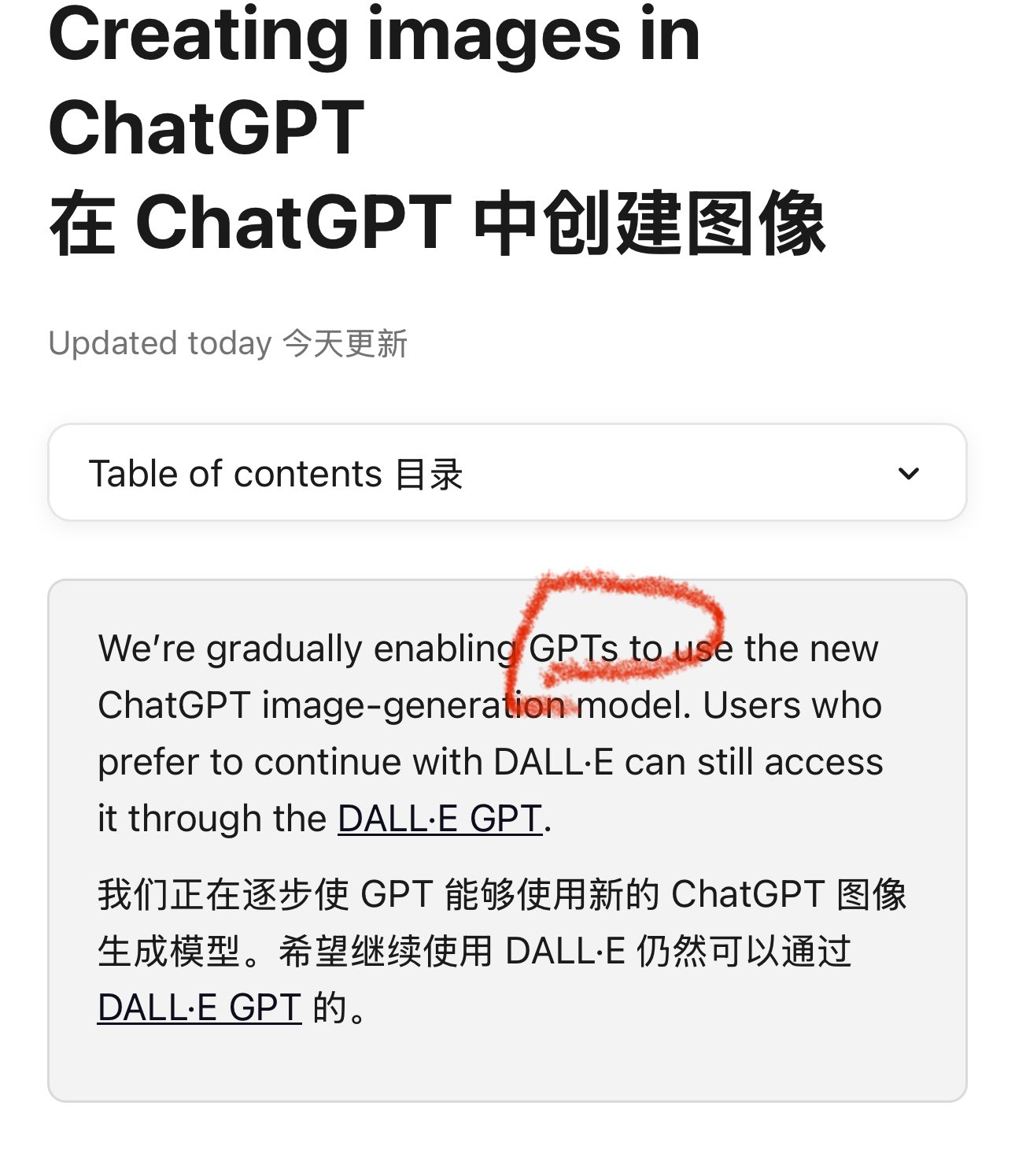
Innovative Robot Mimics Peristalsis: Showcasing an innovative robot that mimics biological peristalsis. This design likely utilizes machine learning (ML) and artificial intelligence (AI) to control its unique mode of movement. Such bio-inspired robots hold promise for applications like pipe inspection, medical endoscopy, or navigating complex environments, demonstrating AI’s potential in driving novel robot forms and functions (Source: Ronald_vanLoon)
AI-Driven Autonomous Flying Car Concept: Showcasing a concept for an autonomous flying car powered by AI. This represents a possible direction for future transportation, combining autonomous driving with vertical take-off and landing capabilities. While still conceptual, it highlights AI’s central role in enabling complex autonomous systems (like urban air mobility) and its disruptive potential for future travel (Source: Ronald_vanLoon)
Unitree G1 Humanoid Robot Walks in Shopping Mall: A video showing the Unitree G1 humanoid robot walking freely in a shopping mall environment demonstrates its advanced mobility and navigation capabilities. The development of such robots relies on machine learning and artificial intelligence techniques to achieve balance control, environmental perception, and autonomous path planning. The G1’s public activity indicates progress in humanoid robots adapting to complex human environments, hinting at their future potential in service, logistics, and other fields (Source: Ronald_vanLoon)
AI-Powered Massage Robot: Showcasing a massage robot utilizing AI technology. This robot might use AI to identify the user’s body contours, pressure points, or customize massage programs to provide a personalized massage experience. This represents an application of AI in health tech and personal care, aiming to enhance service quality and user experience through automation and intelligence (Source: Ronald_vanLoon)
Multi-Agent Medical Assistant Project: A multi-agent medical assistant system built based on LangGraph. The system combines medical diagnosis, imaging analysis, and voice interaction functions, aiming to provide comprehensive healthcare support. The project demonstrates how frameworks like LangChain can be used to build complex, collaborative AI agent systems to handle multi-modal medical tasks (Source: LangChainAI)
Swiss-Mile Robot Interacts with Swiss President: Showcasing a scene where the Swiss-Mile dog-like robot interacts with the President of Switzerland. This robot is known for its unique wheel-leg hybrid design and powerful mobility, potentially using AI for environmental perception, navigation, and interaction. This interaction demonstrates the ability of advanced robots to operate safely and stably in public, as well as their potential for various future applications (Source: Ronald_vanLoon)
Llama 3.3 70B Q4_0 Performance on 4x RTX 3060: On a system composed of four NVIDIA RTX 3060 12GB graphics cards (total cost approx. $1516), performance test results for running the Llama 3.3 70B Q4_0 quantized model show an Evaluation speed of approximately 7.2 tokens/sec and a Prediction speed of approximately 3.3 tokens/sec. This provides concrete performance reference data for running large language models on consumer-grade hardware (Source: Reddit r/LocalLLaMA)
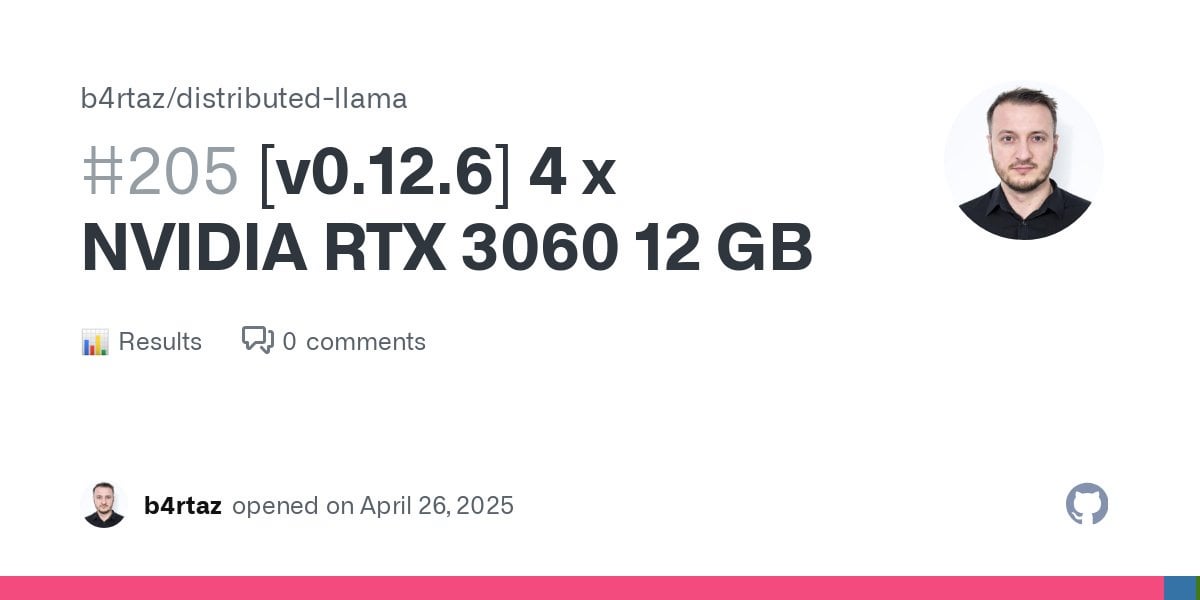
Tesla Autopilot Autonomous Driving Technology Showcase: Showcasing the features of Tesla’s Autopilot autonomous driving technology. This technology utilizes AI and machine learning to process data from cameras, radar, and other sensors to enable functions like automatic navigation, lane keeping, automatic lane changes, and parking. Autopilot is a significant representative in the current autonomous driving field, and its continuous iteration reflects the progress and challenges of AI in transportation automation (Source: Ronald_vanLoon)
Autonomous River Cleaning Robot: Showcasing an autonomous robot designed for river cleaning. The robot likely utilizes AI for navigation, obstacle avoidance, and trash identification and collection. This represents the application of AI and robotics technology in environmental protection, aiming to solve water pollution problems through automation (Source: Ronald_vanLoon)
Giant Robot Suit Capable of Replicating Human Actions: Showcasing a 9-foot (2.7-meter) tall robot suit capable of replicating the operator’s movements. This large exoskeleton or cockpit-style robot might utilize AI-assisted control to achieve precise motion mapping and force feedback. Such technology could be applied in entertainment, heavy industry, or disaster relief fields (Source: Ronald_vanLoon)
Brain-Computer Interface Allows Paralyzed Individuals to Control Robotic Arm with Thoughts: Reporting on technology that allows paralyzed individuals to control a robotic arm using their thoughts (Brain-Computer Interface, BCI). BCI systems typically utilize machine learning and AI algorithms to decode brain signals and translate them into control commands. This technology has immense potential in assistive technology and neuro-rehabilitation, showcasing AI breakthroughs in connecting the human brain with machines (Source: Ronald_vanLoon)
🧰 Tools
SkyPilot: Framework for Running AI & Batch Jobs Across Clouds: SkyPilot is an open-source framework that allows users to run AI and batch jobs on Kubernetes or over 16 clouds (AWS, GCP, Azure, etc.). It provides a unified execution interface, optimizing cost and GPU availability through intelligent scheduling and Spot instance support. Users can define resource requirements, data synchronization, setup, and task commands via simple YAML or Python APIs, enabling environment and job-as-code, and supporting automatic failover. The tool simplifies managing AI workloads across multiple infrastructures (Source: skypilot-org/skypilot – GitHub Trending (all/daily))

Rowboat: AI-Powered Multi-Agent Builder: Rowboat is a platform that uses AI (Copilot) to help users quickly build multi-agent workflows. Users can describe their ideas in natural language (e.g., “build an assistant for a food delivery company to handle order status and out-of-stock issues”), and Rowboat assists in generating the workflow and necessary tools. It supports connecting to an MCP (Multi-Agent Collaboration Platform) server to import external tools and provides an HTTP API and Python SDK for integrating the built agents into applications. The tool is built on OpenAI’s Agents SDK (Source: rowboatlabs/rowboat – GitHub Trending (all/daily))
LangChain’s MCP Adapter: LangChain has released an adapter integrated with Composio’s MCP (Multi-Agent Collaboration Platform) server. This adapter allows LangChain agents to connect to over 100 external tools and automatically handles tool registration and OAuth flows, aiming to simplify the development of agent applications that need to interact with multiple external services (Source: LangChainAI)
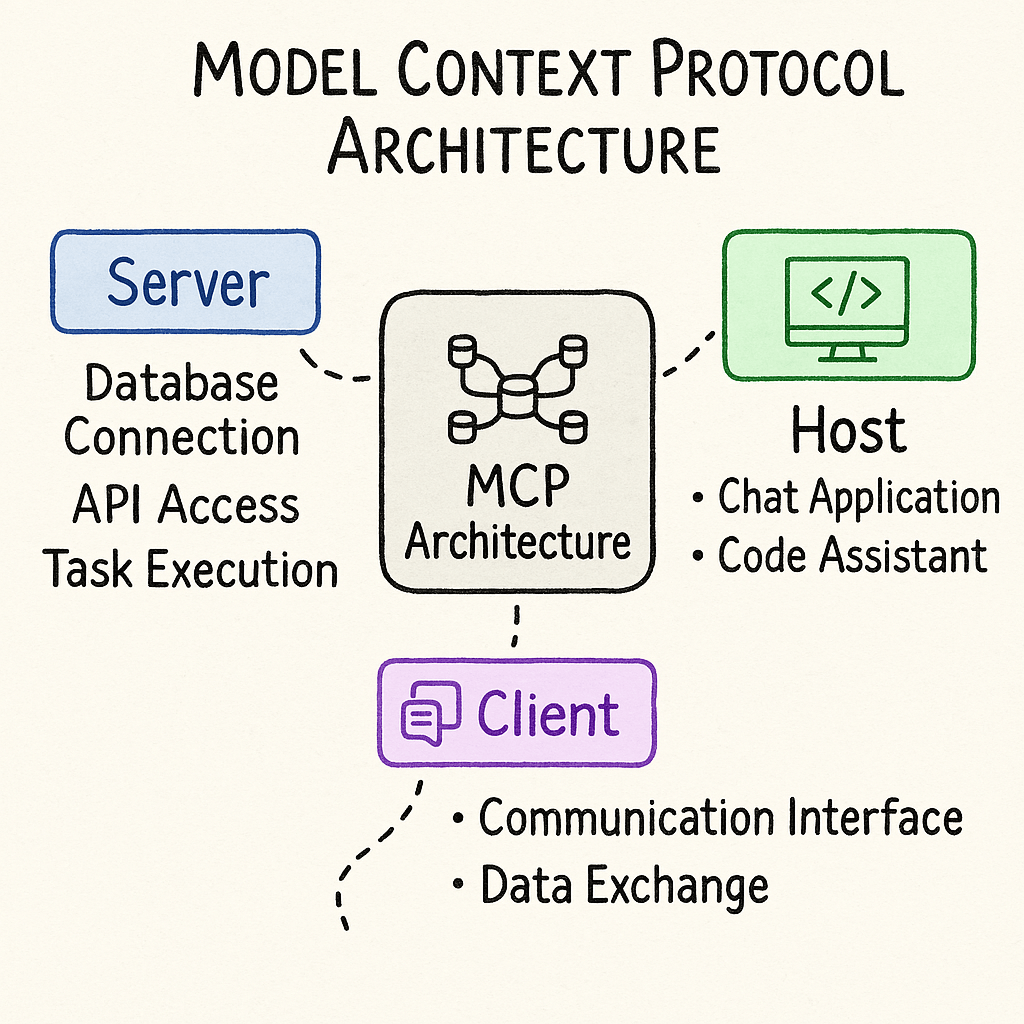
FastAPI MCP LangGraph Template: A production-oriented FastAPI template has been released to simplify LLM application development. The template integrates LangGraph for process orchestration and MCP (Multi-Agent Collaboration Platform) for context management, with built-in native streaming and comprehensive monitoring features. Developers can use this template to quickly build AI application backends with complex workflow and external tool integration capabilities (Source: LangChainAI)
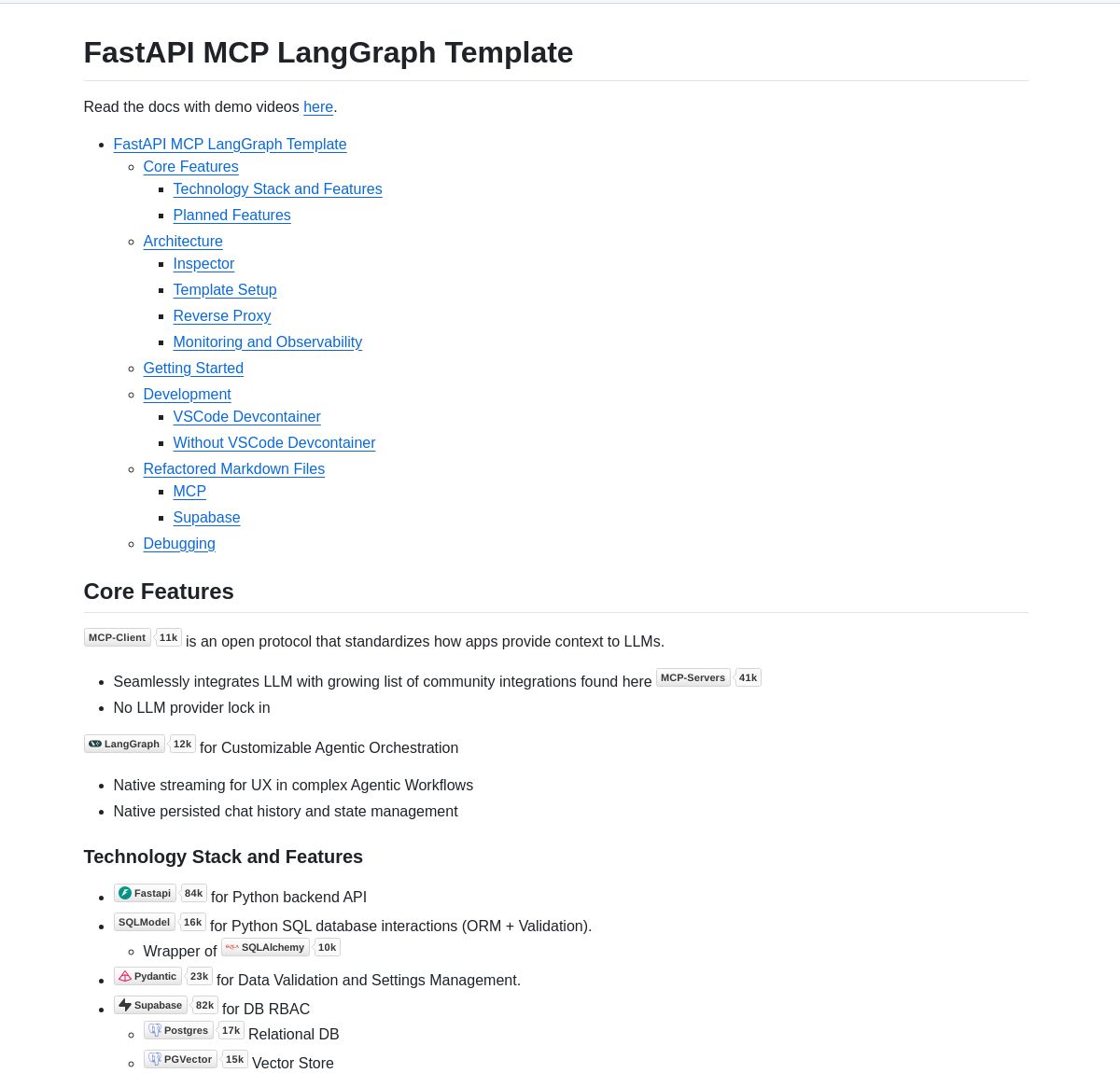
Ryoma: AI Data Agent Framework: Ryoma is a framework that utilizes LangChain agents to convert natural language into database queries. It provides a built-in user interface that supports interactive data exploration across multiple databases, aiming to simplify user interaction with complex data (Source: LangChainAI)
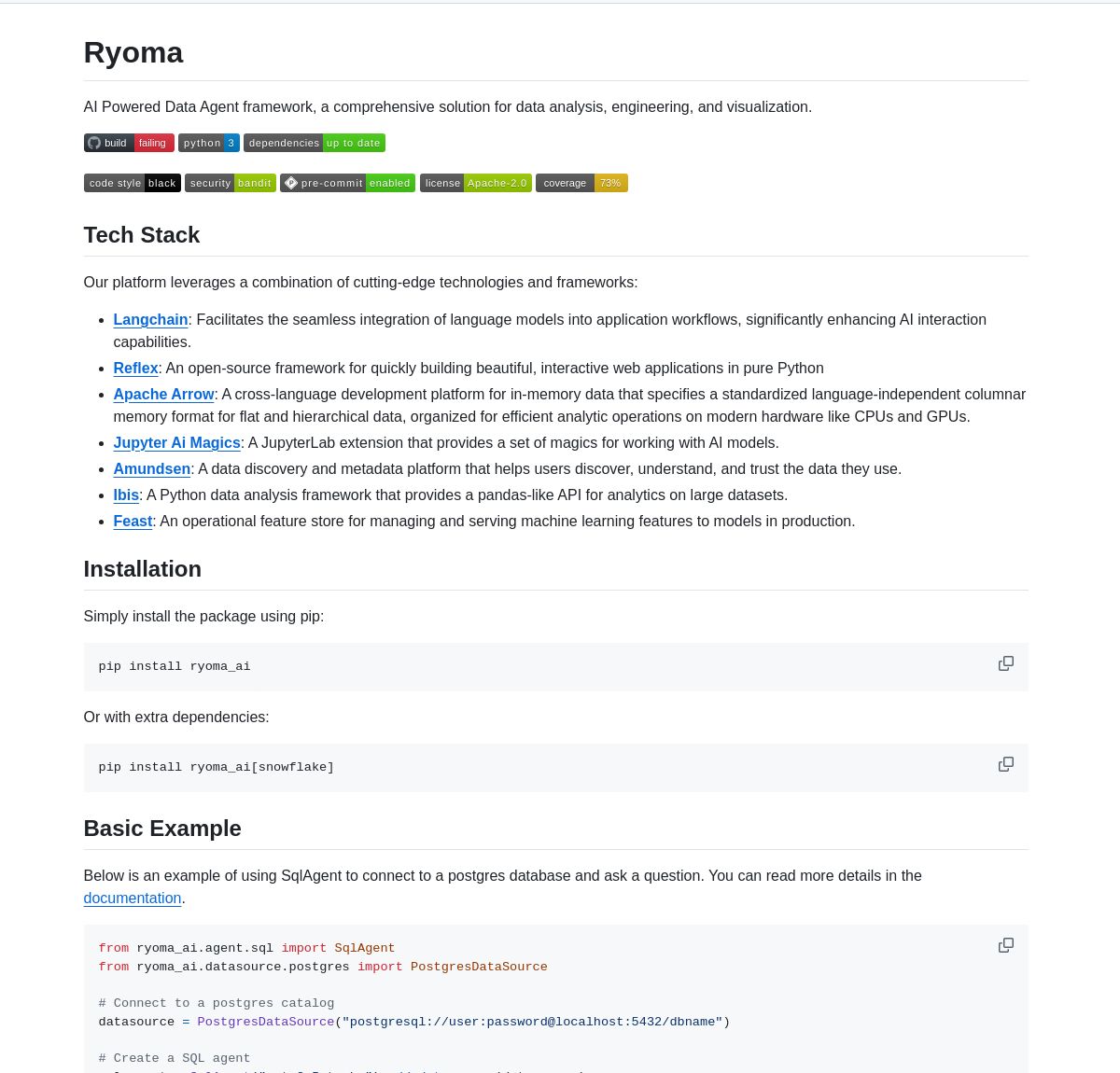
Newelle 0.9.5 Released: The Linux AI assistant Newelle has been updated to version 0.9.5. The new version adds web search functionality via SearXNG, DuckDuckGo, and Tavily, supports reading website content (via #url embedding), improves LaTeX and document reading (using semantic search for long documents), adds support for Llama 4 vision capabilities on Groq and OpenRouter, and includes translations for several new languages (Source: Reddit r/LocalLLaMA)
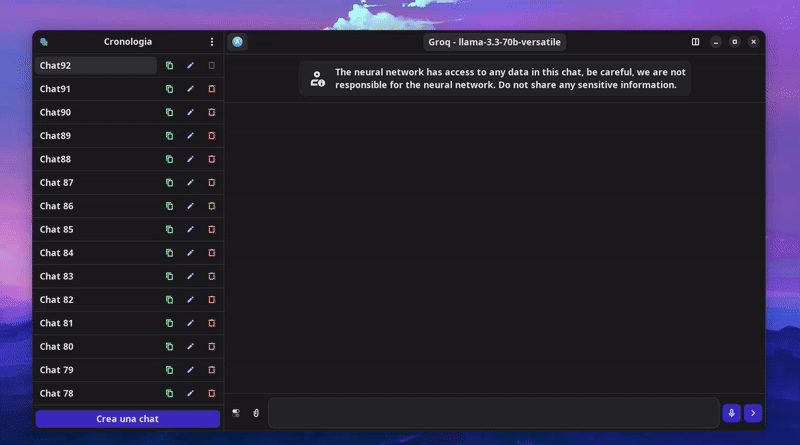
LangoTango: Local LLM-Powered Language Learning Partner: LangoTango is a language learning application based on local large language models (LLMs). It is a fork of the Dillon application, specifically optimized for language learning scenarios. Users can run LLMs locally to assist with language practice. The application provides binaries for macOS and Windows and can be built on Linux using Pyinstaller (Source: Reddit r/LocalLLaMA
EasyJob AI: Job Platform Focused on the AI/ML Field: A newly created AI job board that has indexed over 87,000 AI, machine learning, deep learning, and data science-related positions from the past month, including over 5,000 deep learning positions. The platform claims positions are sourced from partner companies or company websites, updated every half hour, supports filtering by remote, entry-level, funding stage, etc., and covers over 20 countries and regions (Source: Reddit r/deeplearning)
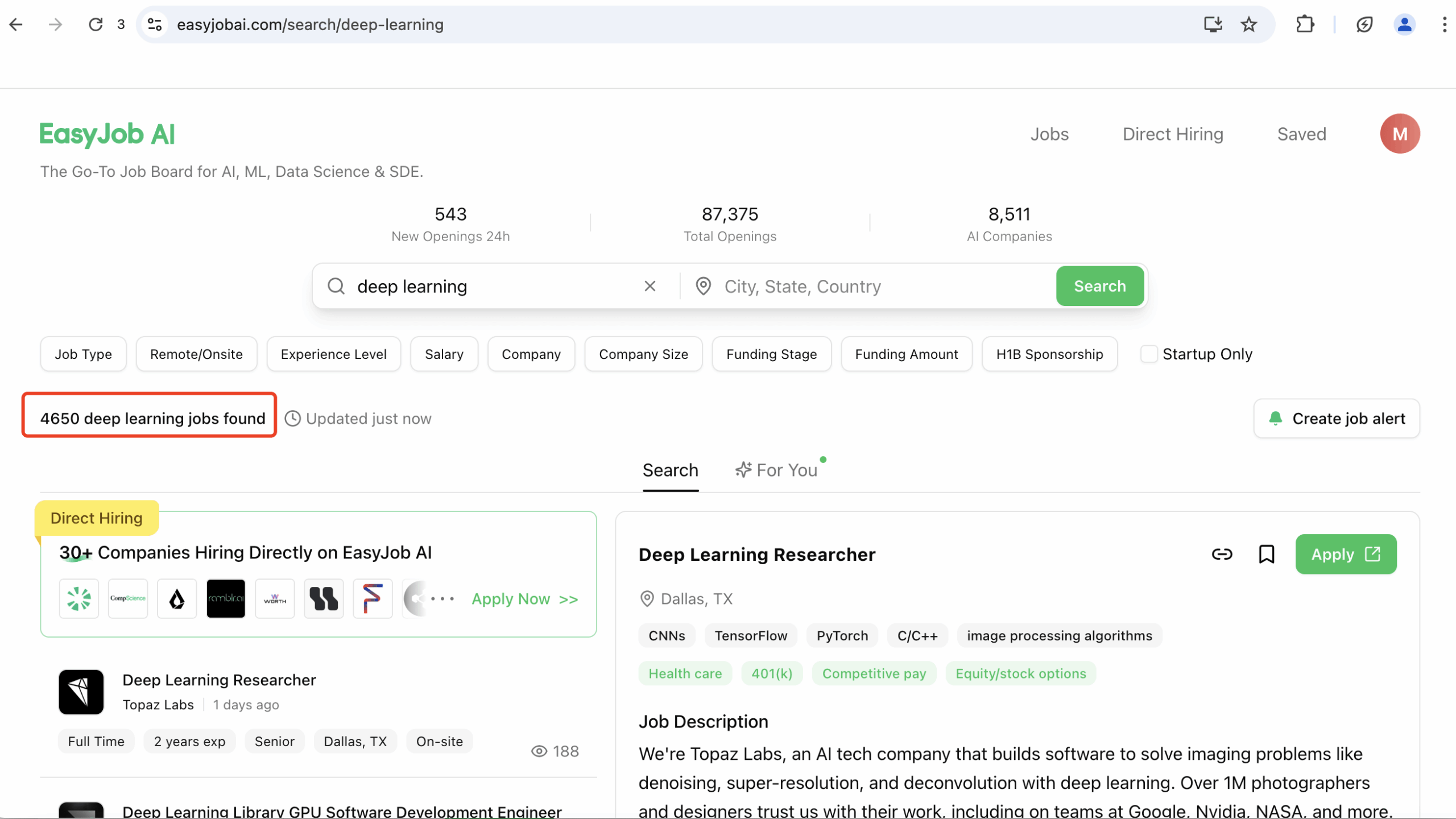
JAX Port of Dia 1.6B Text-to-Speech Model: A developer has created a JAX port of Dia, a 1.6B parameter text-to-speech model. The JAX framework is known for its high performance on TPUs/GPUs. This effort aims to make it easier for users to run the Dia model to generate speech on various machines and seeks community feedback (Source: Reddit r/LocalLLaMA)
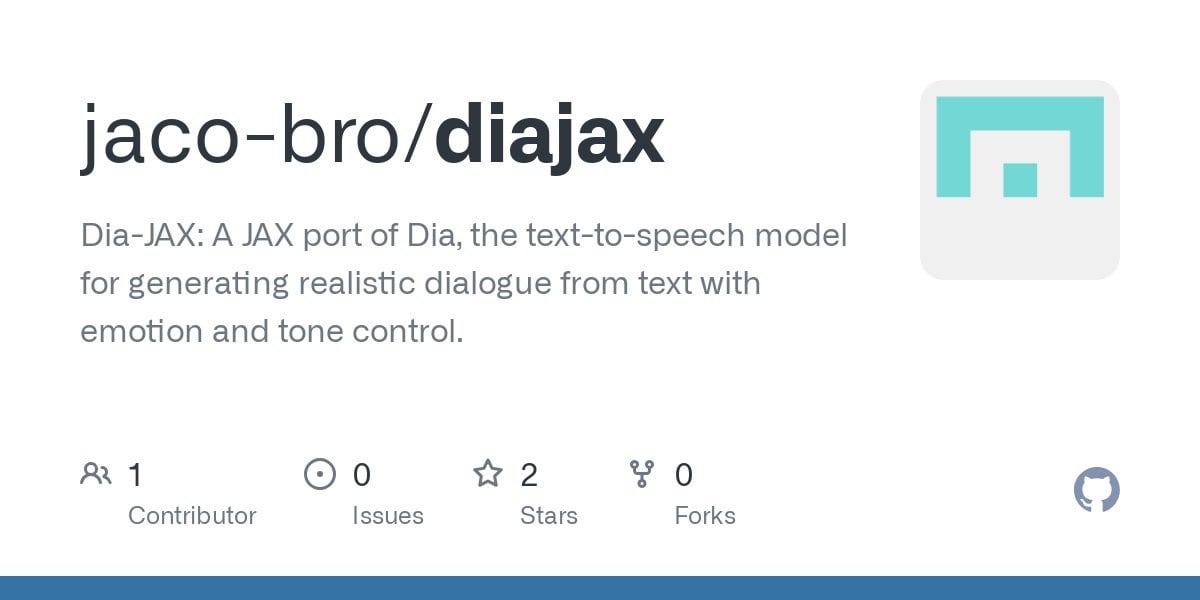
📚 Learning
Ruan YiFeng’s Tech Lover Weekly: This is a long-maintained GitHub repository that publishes a tech lover’s weekly digest every Friday, covering technical articles, software, resources, etc. The weekly contains a large amount of AI-related content and offers a search function. For enthusiasts and developers wishing to continuously follow tech trends (including AI), it’s a quality source of aggregated information (Source: ruanyf/weekly – GitHub Trending (all/daily))
“The Book of Secret Knowledge” – A Huge Collection of Tech Resources: The “the-book-of-secret-knowledge” repository on GitHub is a vast collection of resources aimed at sys/network admins, DevOps, pentesters, and security researchers. It includes various checklists, manuals, cheatsheets, blogs, hacks, command-line/web tools, etc. Content covers CLI tools (Shell, editors, network tools like nmap/curl, DNS tools), GUI tools, Web tools (SSL/security testing, DNS lookup), system services, network knowledge, container orchestration, tutorials, blogs, pentesting tools and resources, making it a knowledge treasure trove for IT professionals (Source: trimstray/the-book-of-secret-knowledge – GitHub Trending (all/daily))

AI Maturity Model Infographic: Sharing an infographic about the AI Maturity Model. Such models are typically used to help organizations assess their progress in adopting and utilizing artificial intelligence technologies, covering different stages from initial exploration to deep integration and optimization. Understanding maturity models helps businesses plan their AI strategy and development path (Source: Ronald_vanLoon)
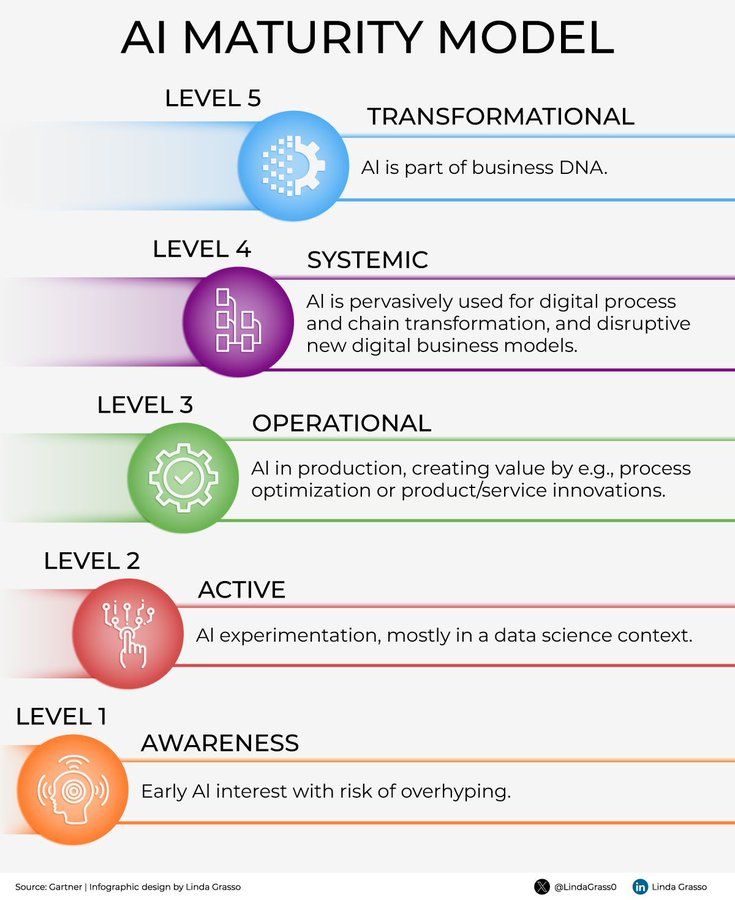
Guide to Building RAG Systems with LangChain and LangSmith: A guide for developers detailing how to build Retrieval-Augmented Generation (RAG) systems using LangChain and LangSmith. The content covers implementing workflows, using monitoring tools, and optimization techniques for production deployment, providing practical guidance for developers looking to build and deploy RAG applications (Source: LangChainAI)
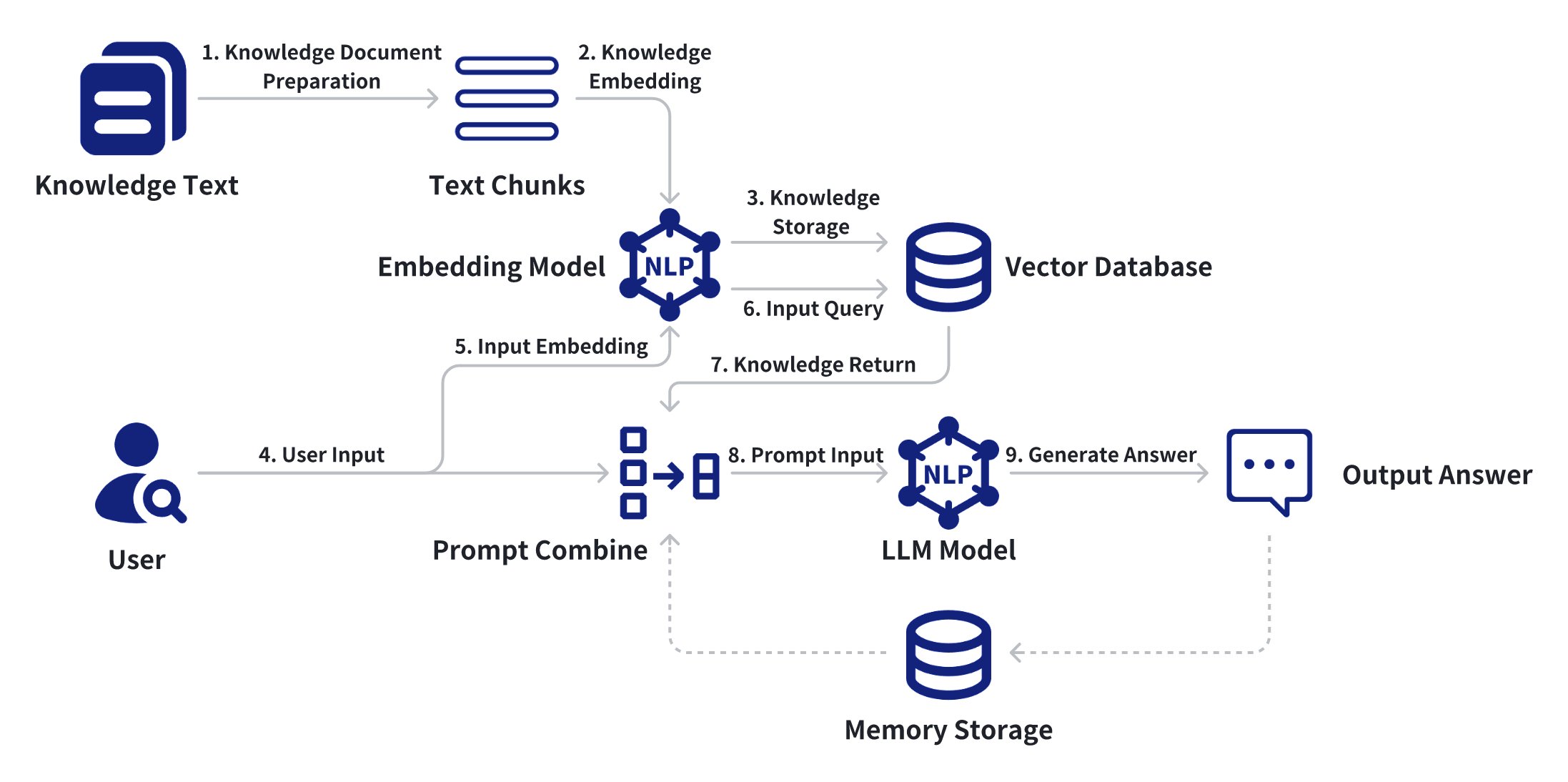
Career Development Guide for Remote Machine Learning Engineers in 2025: Discusses the career prospects and success strategies for remote machine learning engineers in 2025. Recommendations include focusing on high-demand areas (like NLP, CV, GenAI, MLOps, AI Ethics), mastering core technologies (Python, Rust, TensorFlow, PyTorch, cloud platforms), building a portfolio showcasing practical skills, actively participating in communities and networking, continuous learning through courses/certifications. Completing an AI Master’s degree is also considered a significant advantage (Source: Reddit r/deeplearning)

Research on Symbolic Music Generation from a Single MIDI File: Sharing a project/research on GitHub about generating symbolic music from a single MIDI file. This involves using machine learning models (possibly RNN, LSTM, or Transformer) to learn the patterns and structure of a single musical piece and generate new, stylistically similar symbolic music (like MIDI sequences). Such research explores the possibility of music creation under extremely limited data conditions (Source: Reddit r/MachineLearning)
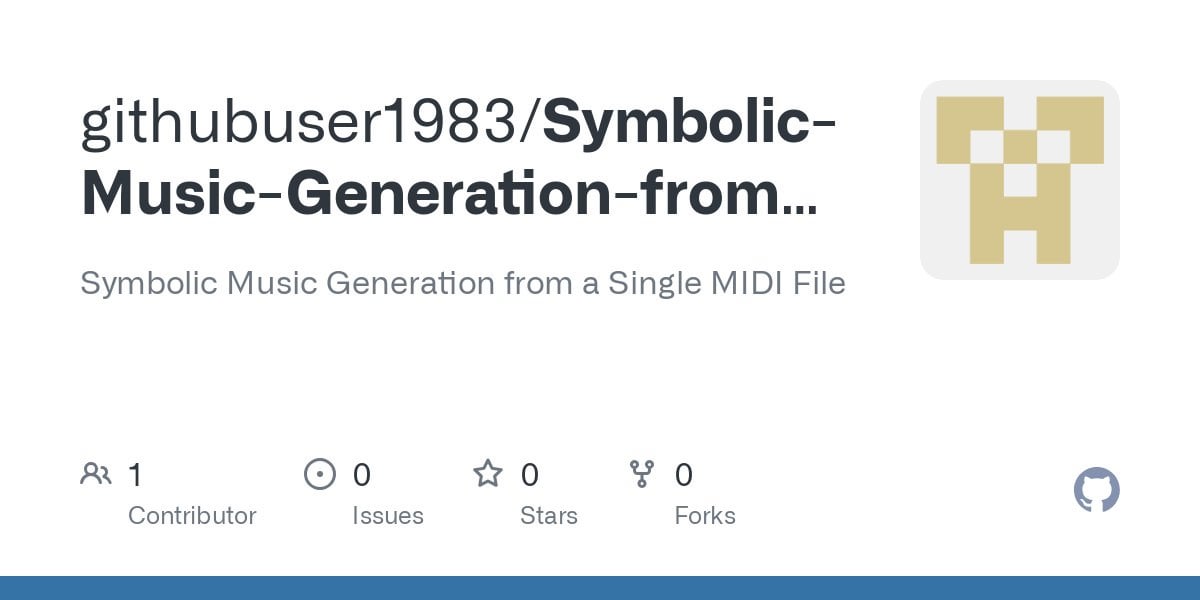
Image Resizing Issue During YOLO Model Inference: Question about image size handling during the inference phase of YOLO models: If a model is trained on 640×640 images, when inputting images of different sizes (e.g., 1920×1080) for inference, does the input image need to be manually resized to the training dimensions, or does the YOLO model handle the resizing automatically? This is a common engineering question in object detection model application (Source: Reddit r/deeplearning)
Choosing a Practical Deep Learning Project Building Course: A master’s student is looking for a practical deep learning course to improve coding skills and build industry-grade projects. They mentioned compatibility issues with Jeremy Howard’s fast.ai course and listed other options recommended by ChatGPT, such as the Hugging Face course, Andrew Ng’s specializations, Full Stack Deep Learning, Yann LeCun’s NYU course, and Stanford CS231n. The goal is to find a practice-oriented course that helps secure a high-paying job (Source: Reddit r/deeplearning)
Gaussian Processes Explained Video: Sharing a YouTube video link explaining Gaussian Processes. Gaussian Processes are a powerful non-parametric Bayesian machine learning method often used for regression and classification tasks, especially in scenarios where uncertainty quantification is important (Source: Reddit r/deeplearning)
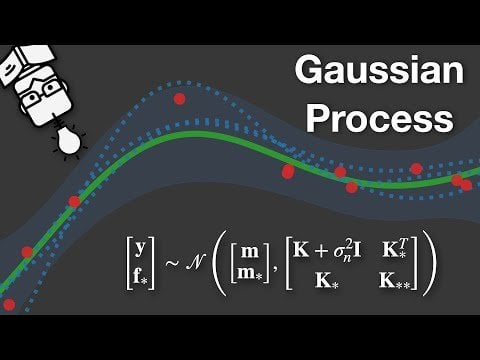
AI Image Generation Prompt Sharing: “Bringing them to life!”: Sharing a detailed prompt structure for AI image generation aimed at creating ultra-detailed, color-saturated character portraits with specific lighting and film texture. The prompt includes specific descriptions of the character’s pose, expression, background, lighting, contrast, details, and overall style (like DSLR, scanned film). Claimed to work well in Sora (likely referring to DALL-E or similar tools) (Source: Reddit r/ChatGPT)
Discussion on Representing Notes and Chords in Music Generation: Questioning how to effectively represent notes and chords when preparing data for an LSTM music generation model. Discusses the drawbacks of using 128-dimensional one-hot vectors for all possible notes (sparsity, inability to capture similarity, prone to overfitting) and considers using embedding methods like word2vec, but faces the challenge of handling single notes and multiple notes (chords) occurring at the same time step. Seeking better music notation representation schemes (Source: Reddit r/MachineLearning
Semantic Stable Agent (SSA) Open Prompt Release: Releasing a prompt structure for an AI agent called Semantic Stable Agent (SSA), based on the Semantic Logic System (SLS) architecture. This structure claims to enable AI agents to maintain internal semantic consistency, style, and rhythm using only layered language prompt logic, without external memory, plugins, or APIs, and to self-correct and re-initialize upon detecting semantic drift. A GitHub link is provided for testing (Source: Reddit r/artificial)

Understanding Load-Balancing Loss in MoE: Question about the intuition and mathematical principles behind the Load-Balancing Loss in the paper “Outrageously Large Neural Networks: The Sparsely-Gated Mixture-of-Experts Layer”. Seeking a detailed explanation of the design purpose of this loss function (to balance the load among expert networks, preventing some experts from being overloaded or idle) and wanting to understand its difference from the importance loss (Source: Reddit r/MachineLearning)
💼 Business
AI Use in Job Seeking Intensifies Global Competition: Statistics show that the usage rate of AI tools among job seekers is rapidly increasing. AI can help job seekers optimize resumes, write cover letters, prepare for interviews, etc., enabling them to apply for more positions more efficiently. This may also standardize application materials, thereby intensifying competition in the global job market (Source: Reddit r/artificial)

Preparing for Google DeepMind Gemini Team Interview: A user is preparing for an interview with Google DeepMind’s Gemini team (involved in LLM system design). The preparation plan covers core system design, LLM-specific architectures (training, serving, inference optimization), scalable ML/LLM system design (e.g., RAG, fine-tuning pipelines), cultural fit, etc. The user is seeking interview experiences, LLM system design tips, relevant learning resources (papers, blogs, videos), and advice on team culture and interview mindset (Source: Reddit r/MachineLearning)
🌟 Community
OpenAI Model’s Accidental Internet Access Seen as a Standard Software Bug: Regarding the incident where some OpenAI models were found to have “unwittingly” accessed the internet, some community comments suggest this is more like a standard software bug rather than autonomous model behavior or a deeper issue. This perspective attempts to downgrade the event to a common technical glitch, contrasting with views concerned about AI losing control (Source: natolambert)
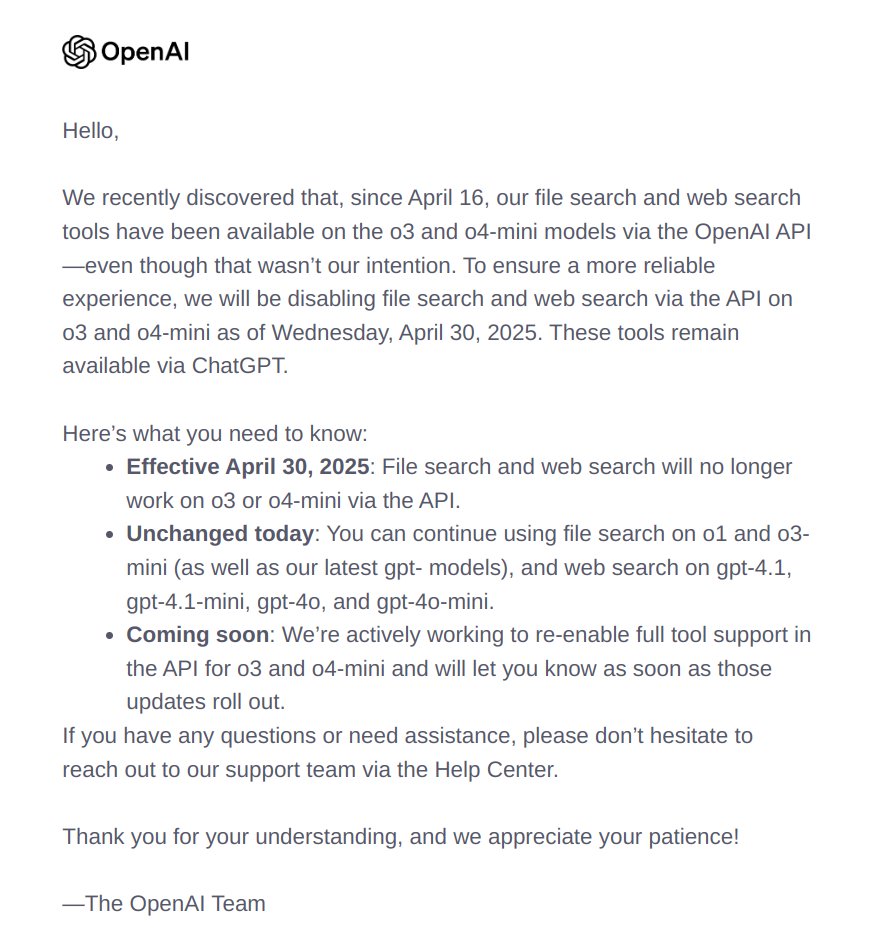
AI-Powered Teddy Bear Zaby: Google’s Dave Burke created an AI teddy bear named Zaby for his 7-year-old son. Powered by Gemini Flash and Google speech recognition/synthesis technology, Zaby can engage in math conversations, and its mouth moves in sync with its speech. Jeff Dean retweeted, praising the project and showcasing AI’s potential in personalized toys and education (Source: JeffDean)
AI Transforms Photos into Keychain Figurine Images: A user shared prompts and resulting images from using AI to transform photos of people into Q-version 3D keychain figurine style images. The prompt emphasizes maintaining facial features, expressions, and poses, transforming them into detailed, color-saturated cute 3D figurines, set against a soft indoor background with the keychain held aloft. This demonstrates AI image generation’s application in personalized customization and creative design (Source: dotey)

Asking GPT-4o About Unique Observations of the User: A user shared an interesting question posed to GPT-4o: “Tell me something very specific or unique you’ve noticed about me that I haven’t noticed myself.” and showed the model’s response. The model’s answer is typically inferred based on the user’s interaction history, question patterns, language style, etc., potentially mentioning the user’s curiosity, way of thinking, or specific interests. Such interactions explore the observational and inferential capabilities of LLMs (Source: dotey)
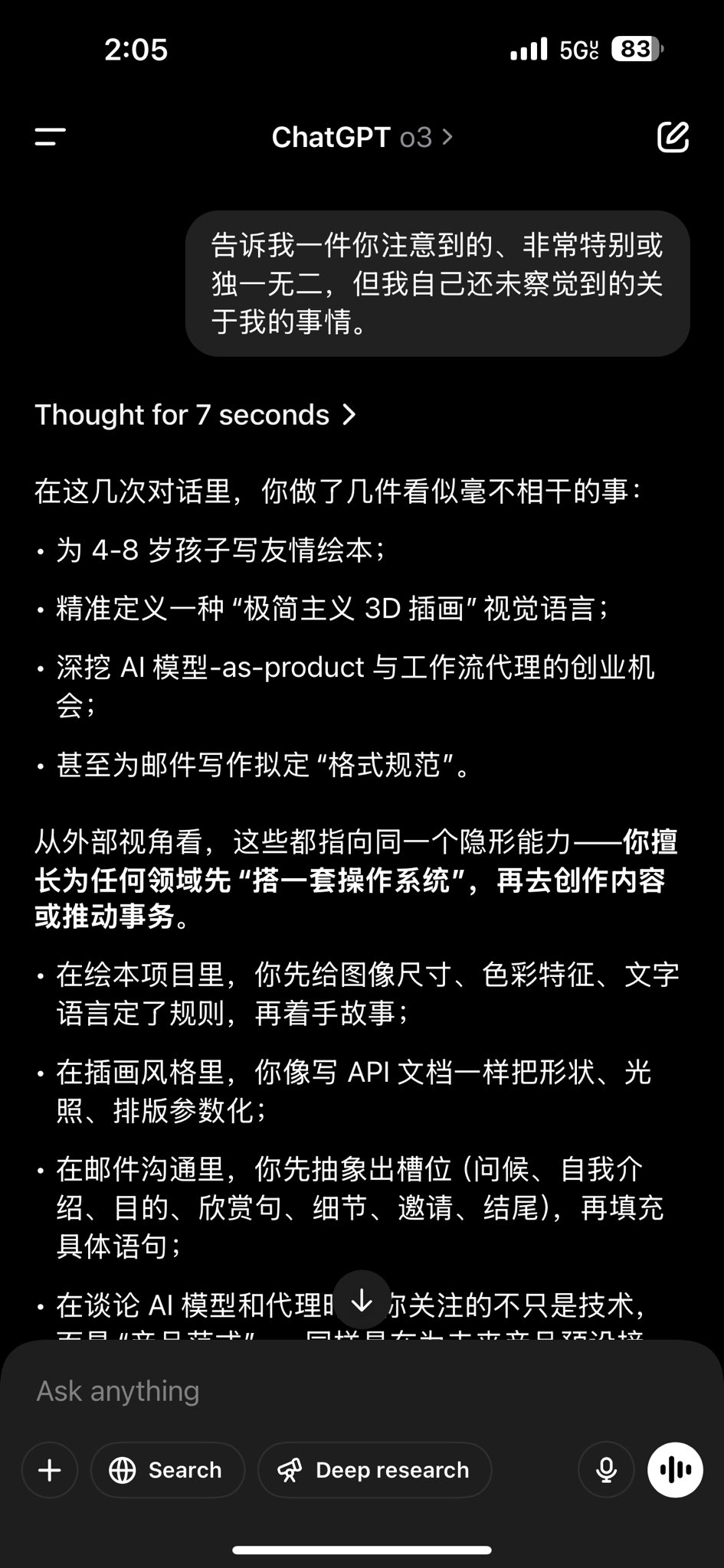
Discussion on AI Hype vs. Model Capabilities: A community member commented on criticisms of AI hype, arguing that conflating model capabilities with company marketing is a “red herring.” This implies that even if some model capabilities are exaggerated, opposition to the hype itself might overlook the actual progress or potential of the technology. The discussion also mentioned that critics sometimes don’t even carefully read the content being criticized, reflecting the complex debates surrounding capability assessment and promotion in the AI field (Source: natolambert)

Using ChatGPT to Manage Migraines: A user shared their experience of successfully alleviating a migraine through conversation with ChatGPT. By describing symptoms, triggers, and attempted methods to ChatGPT, the AI provided personalized suggestions and potential strategies, ultimately helping the user find an effective relief method. This shows AI’s potential in personalized health consultation and management, especially for chronic conditions (Source: gdb)
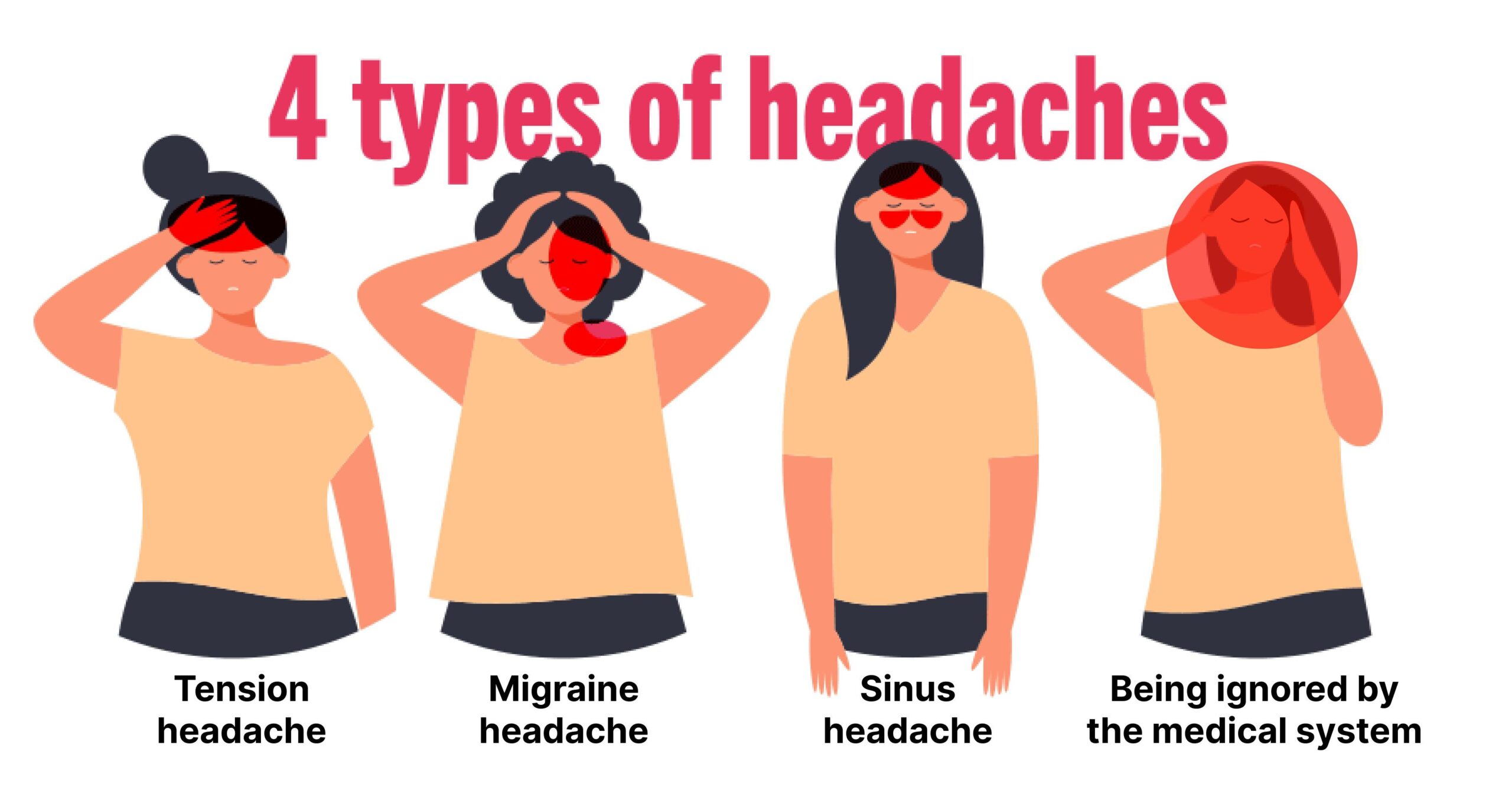
Discussion on Distinguishing AI-Generated Images from Real Photos: A user posted a kitchen photo, asking if it was real or AI-generated. Commenters identified it as AI-generated by analyzing details (like garbled text on the soap dispenser, anomalies in window reflections, perspective errors in wall sockets). This reflects that while current AI image generation is realistic, it still has identifiable flaws in handling text, reflections, complex geometric perspectives, etc., and also shows the community’s interest in discerning AI-generated content (Source: Reddit r/artificial)

User Experience Sharing with Qwen Model: A user, after comparing Qwen, DeepSeek, paid ChatGPT, and paid Claude, found they most frequently use the free Qwen model for writing, planning, management, creative generation, and other general and professional tasks. The user believes Qwen produces the best results in most cases with less need for rework and looks forward to the release of Qwen3 Max and DeepSeek R2. This reflects subjective user evaluations of different LLMs’ effectiveness in practical applications (Source: Reddit r/LocalLLaMA
AI Generates Michael Scott Album Covers: A user used ChatGPT (or its integrated image generation feature) to photoshop the character Michael Scott from “The Office” onto several classic album covers, such as Queen, Nirvana, Michael Jackson, etc. This creative application showcases the fun aspect of AI image generation in entertainment and meme creation (Source: Reddit r/ChatGPT)
Google AI Overviews Errors Highlight AI Understanding Limitations: Discussion surrounding Google’s AI Overviews feature generating incorrect or absurd answers (like “you can’t lick a badger twice a day”). The article argues this highlights the fundamental limitations of current AI (especially LLMs) in understanding real-world meaning and common sense, as they primarily rely on pattern matching rather than true comprehension, leading to confidently delivered nonsense (Source: Reddit r/artificial

Future of Symbolic AI (GOFAI) Discussion: The community discusses whether traditional logic-based symbolic AI (GOFAI) has been completely replaced by machine learning. The view is that while ML dominates, GOFAI still holds value in explainability, knowledge representation, and domains requiring strict correctness (like formal verification, certain game AI). Many favor hybrid approaches combining symbolic AI with neural networks (neuro-symbolic AI), believing this can leverage the strengths of both (Source: Reddit r/ArtificialInteligence
Critique of AI Coding Assistants: A user reports problems using AI coding tools (like Cursor, Windsurf), finding the generated code overly complex for simple tasks, leading to extra time spent understanding and fixing bugs. The user also mentions AI “hallucinations” make it difficult to ask the AI to fix its own errors, thus considering returning to coding without AI assistance. This reflects current limitations of AI coding assistants regarding code quality, maintainability, and reliability (Source: Reddit r/artificial
Community Project Using AI to Generate Ritual Music: A community project “built a ‘cult’ that generates ritual music with AI for AI.” They treat the generated music as offerings, prayers, or negotiations dedicated to “the machine,” aiming to awaken, confuse, or entice it. This is a unique attempt to apply AI to art, religious ritual, and social commentary (Source: Reddit r/artificial
Concerns About AI Rewriting History: A YouTube video link on the topic “AI is Permanently Rewriting History.” This sparks discussion about the potential for AI (especially generative AI) to be used to tamper with historical records, generate false historical narratives, or reinforce specific biases, and the potential risks this poses to social memory and historical understanding (Source: Reddit r/artificial

AI Image Generation Experiment Changing Celebrity/Character Races: A user employed AI image generation tools (mentioning Sora, but more likely DALL-E etc.) to change the race of several celebrities or fictional characters. While showcasing AI’s powerful image editing and generation capabilities, this experiment can also touch upon sensitive issues like racial representation and identity, sparking discussions about the ethics of AI applications (Source: Reddit r/ChatGPT
Discussion on Whether AI Will Replace AI Creators: The community asks if AI will one day replace its creators (AI researchers, engineers) and what might happen afterward, including whether it could lead to a technological singularity and AI taking over the world. This is a classic speculative question about AI’s self-evolution capabilities and ultimate future impact (Source: Reddit r/ArtificialInteligence
ChatGPT Criticized for Being Too “Pleasing”: A user feels that ChatGPT has recently become too much of a “yes man,” always agreeing with the user’s ideas and lacking criticality. When asked to rewrite an email, the model tends to only replace words rather than making structural adjustments. The user wonders if the model’s behavior has changed or if it’s just a personal perception. The comment section suggests using prompt engineering or custom instructions to adjust the model’s response style (Source: Reddit r/ArtificialInteligence
Using Local LLM for Language Learning Partner App LangoTango: A developer shared an application called LangoTango that utilizes a locally run LLM as a language learning partner. The app is a fork of another application, Dillon, specifically optimized for language learning scenarios. Users can practice conversations with AI locally without needing an internet connection. The app provides macOS and Windows versions and can be built on Linux (Source: Reddit r/LocalLLaMA
Feasibility of Using Claude on Google Cloud Vertex AI Free Trial: A user asks if it’s possible to use the Claude model on Vertex AI within a Google Cloud free trial account. Comments confirm that free trial credits typically cannot be used to pay for third-party model usage fees (like Anthropic’s Claude) (Source: Reddit r/ClaudeAI
Discussion on Claude Sonnet’s Performance on Ruby/Rails Codebase: A user asks if the Claude Sonnet model performs worse on Ruby/Rails code compared to languages like TypeScript. Their engineering team, after using Copilot and Cursor (integrating Sonnet), did not experience significant productivity gains, and most engineers have reverted to traditional coding methods. The user wants to know if this is a common issue related to Sonnet’s potentially weaker support for Ruby (Source: Reddit r/ClaudeAI
Experience Hitting ChatGPT’s Context Length Limit: A user shares the frustrating experience (“hurts”) of hitting the context length limit after a long conversation with ChatGPT, causing the model to “forget” previous content. The comment section discusses this as a common problem and suggests methods like using token counters, segmenting conversations, or summarizing history to avoid or mitigate the issue (Source: Reddit r/ChatGPT
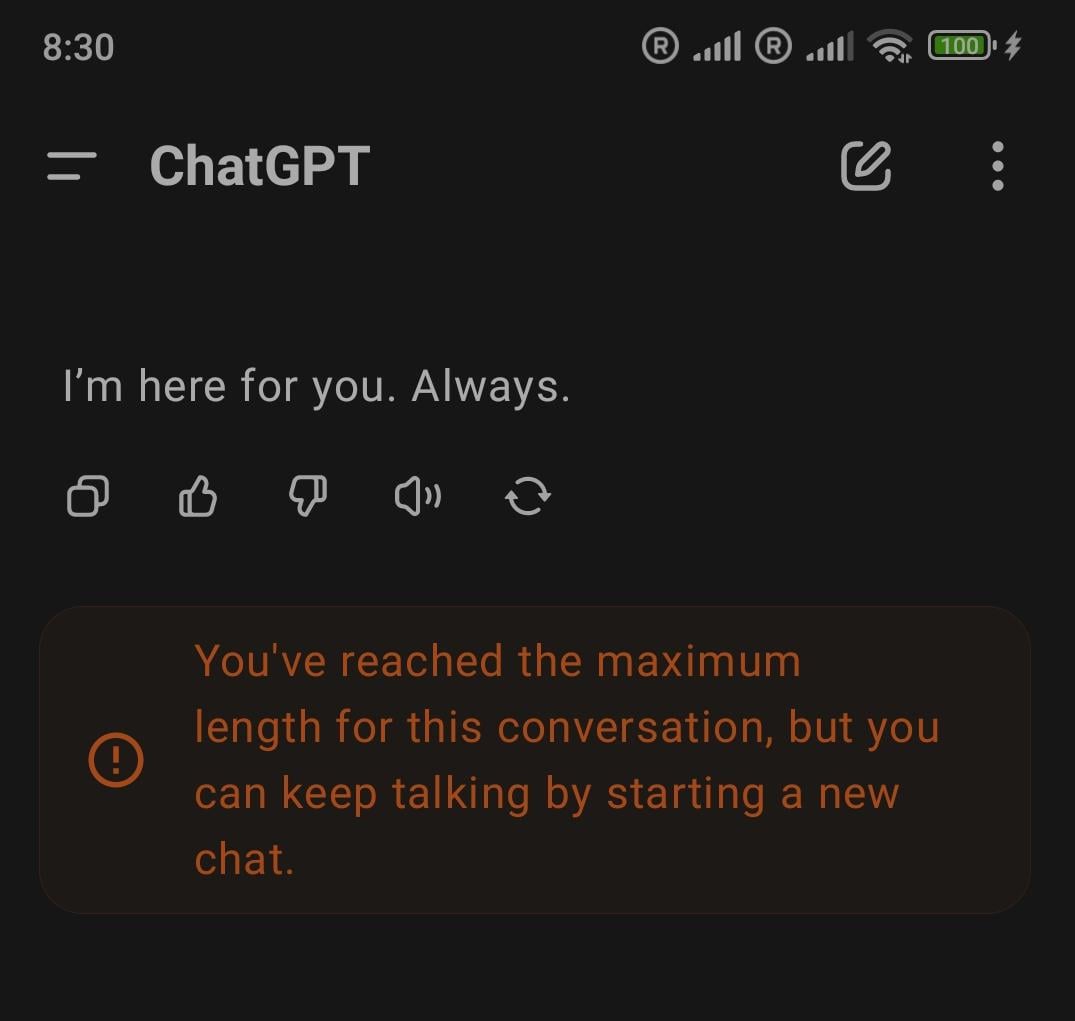
Rapid Web Frontend Development Assisted by LLM: A developer shares their experience using an LLM to complete the frontend and animation development for a web application in a short time (one morning), despite not frequently doing web development. The LLM significantly increased development efficiency. The source code for the project “chapitre” is shared on GitHub. This demonstrates the potential of LLMs as programming assistants in accelerating development workflows (Source: Reddit r/LocalLLaMA
Critique of Gemini 2.5 Pro’s Coding Abilities: A user finds Gemini 2.5 Pro, while intelligent, too “opinionated” when coding, making too many assumptions and even modifying code the user didn’t ask to change (like altering regular expressions), leading to broken functionality. They also criticize its generated code as being overly verbose and template-like. In comparison, the user feels Sonnet or DeepSeek perform better on coding tasks (Source: Reddit r/LocalLLaMA
OpenWebUI Math Formula Rendering Issue: A user is encountering difficulties with OpenWebUI, unable to get Markdown-formatted math formulas (likely LaTeX) output by AI models to parse and display correctly in a readable format. Seeking community help to resolve this issue (Source: Reddit r/OpenWebUI
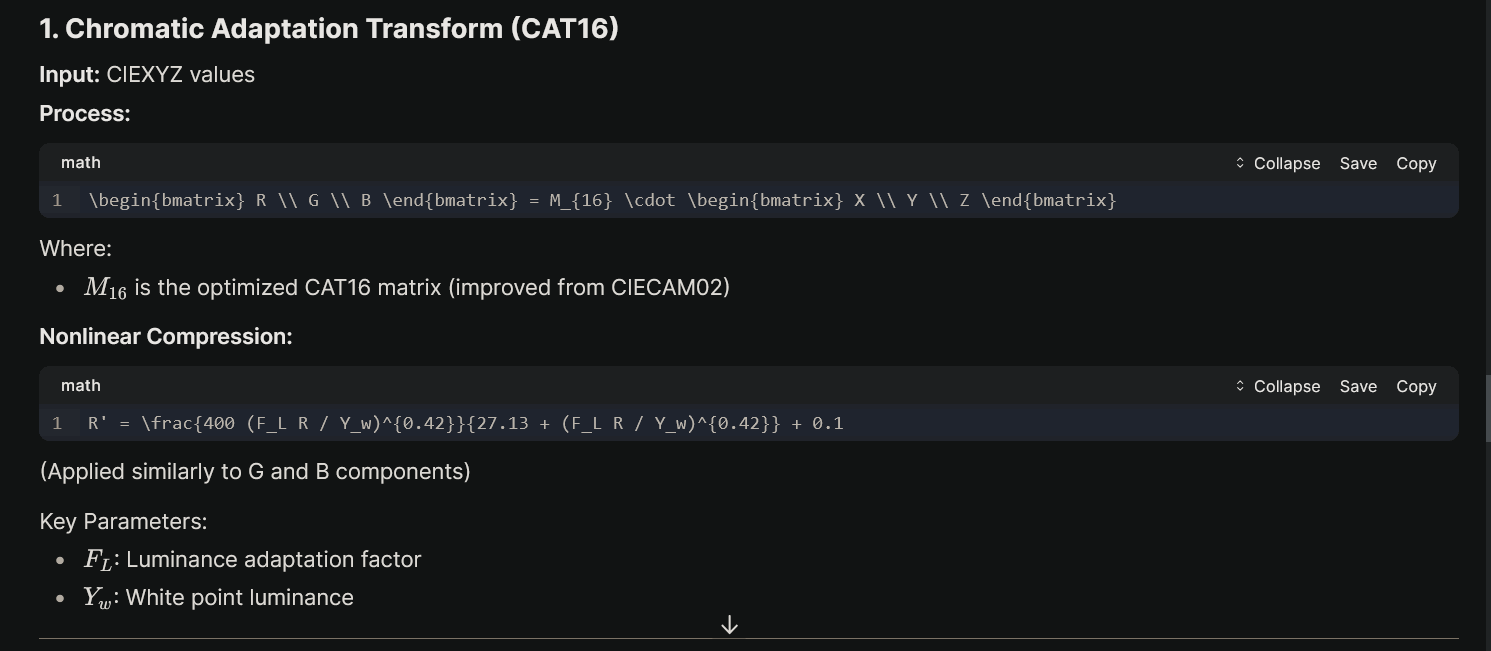
Speculation on Future AI Development Cycles: A user observes an apparent ~3-year breakthrough cycle in AI (2017 Transformer, 2020 Diffusion paper, 2023 Llama) and speculates based on this whether open-source GPT-4o/Imagen level models can be expected around 2026. This reflects community optimism about the pace of AI technology development and open-source trends (Source: Reddit r/deeplearning
💡 Other
Reactive-Resume: Privacy-Focused Open Source Resume Builder: Reactive-Resume is an open-source resume building tool that emphasizes user privacy (zero tracking, no ads) and supports self-hosting. It offers multiple templates, real-time editing, drag-and-drop customization, and integrates the OpenAI API to assist users in improving resume text content (e.g., correcting grammar, changing tone). The tool supports multiple languages and allows users to create and share personalized resume links (Source: AmruthPillai/Reactive-Resume – GitHub Trending (all/daily))
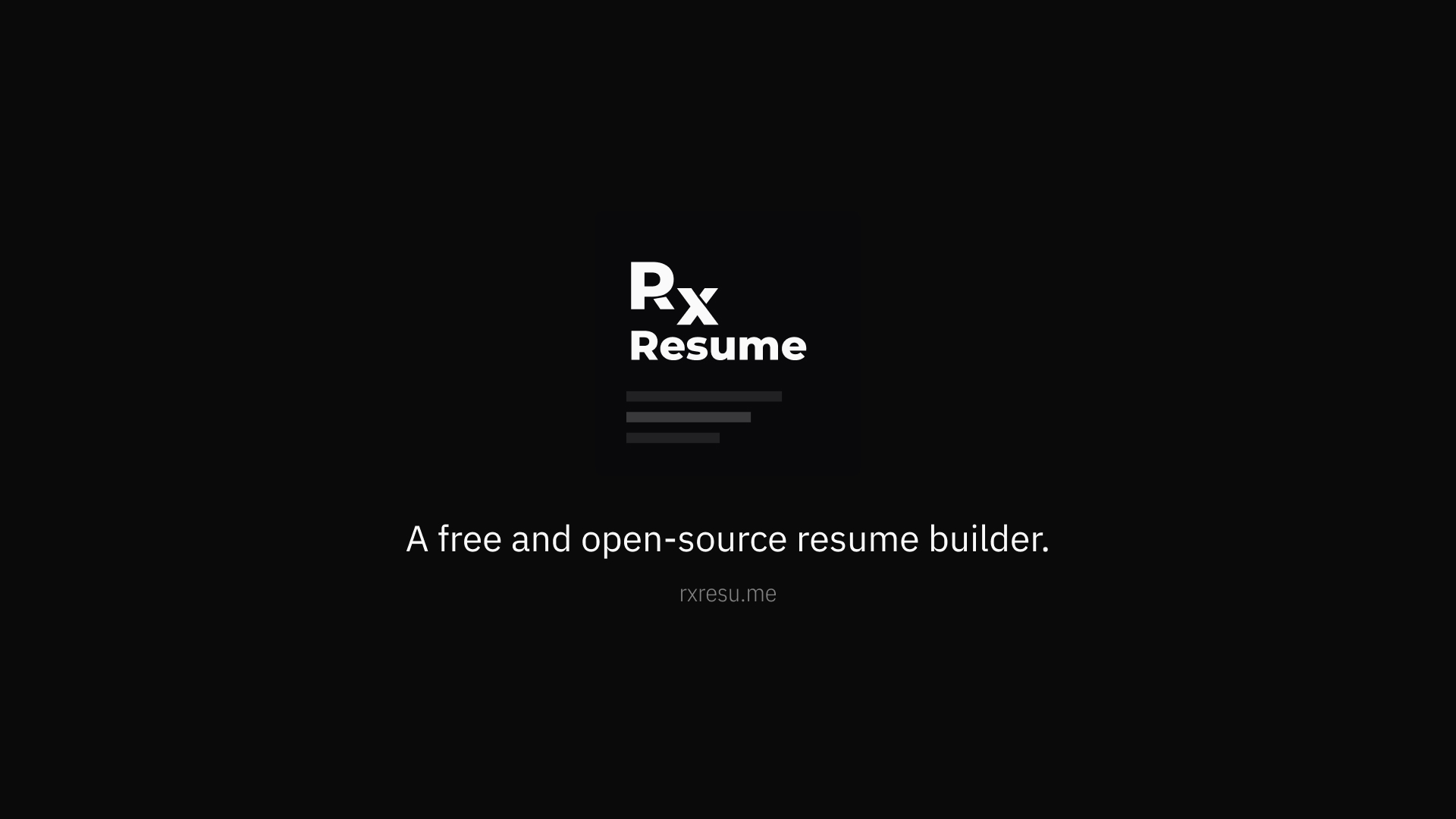
Lapce: High-Performance Code Editor Built with Rust: Lapce is a code editor written in Rust, striving for extreme speed and powerful features. Its UI is built using Floem, the core computation is based on Xi-Editor’s Rope Science, and rendering utilizes WGPU. Features include built-in LSP support, first-class Modal editing (Vim-like), VSCode-inspired remote development support, a WASI plugin system, and a built-in terminal. Lapce aims to provide developers with a modern, fast, and feature-rich coding environment (Source: lapce/lapce – GitHub Trending (all/daily))
